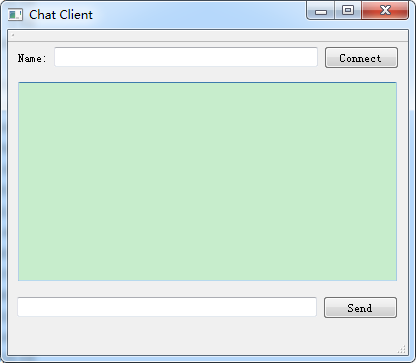Qt NetWork即时通讯网络聊天室(基于TCP)
本文使用QT的网络模块来创建一个网络聊天室程序,主要包括以下功能:
1、基于TCP的可靠连接(QTcpServer、QTcpSocket)
2、一个服务器,多个客户端

3、服务器接收到某个客户端的请求以及发送信息,经该信息重定向发给其它客户端
最终实现一个共享聊天内容的聊天室!
开发测试环境:QT5.12.0 + Qt Creator 4.8.0 + MinGW7.3
代码如下:
1、服务器 QtInstantMessagingServer
基于Console的应用程序,因为这里不需要界面。
QT += core network
QT -= gui
|
1
2 3 4 5 6 7 8 9 10 11 12 13 14 15 16 17 18 19 20 21 22 23 24 25 26 27 28 29 30 31 32 33 |
#ifndef SERVER_H
#define SERVER_H #include <QObject> class Server : public QObject void startServer(); signals: public slots: private: #endif // SERVER_H |
|
1
2 3 4 5 6 7 8 9 10 11 12 13 14 15 16 17 18 19 20 21 22 23 24 25 26 27 28 29 30 31 32 33 34 35 36 37 38 39 40 41 42 43 44 45 46 47 48 49 50 51 52 53 54 55 56 57 58 59 60 61 62 63 64 65 66 67 68 69 70 71 72 73 74 75 76 77 78 79 80 81 82 83 84 85 86 87 88 89 90 91 92 93 94 95 96 97 98 99 100 101 102 103 104 105 106 107 108 109 110 111 112 113 114 115 116 |
#include "Server.h"
Server::Server(QObject *parent) : QObject(parent) } void Server::startServer() } void Server::sendMessageToClients(QString message) } void Server::newClientConnection() // When a client is disconnected from the server, the disconnected() signal will be triggered // whenever a client is sending in a message to the server, the readyRead() signal will be triggered. // This function gets triggered whenever a client's network state has changed, |
|
1
2 3 4 5 6 7 8 9 10 11 12 13 |
#include <QCoreApplication>
#include "Server.h" int main(int argc, char *argv[]) Server* myServer = new Server(); return a.exec(); |
2、客户端QtInstantMessagingClient
基于Widget的应用程序,客户端需要一个友好的界面,父类QMainWindow,MainWindow.ui定义界面如下:

可以给不同的客户端取个名字,如“Michael”、“James”等等,点击“Connect”按钮连接服务端,此时Label变为“Disconnect”。
QT += core gui network
|
1
2 3 4 5 6 7 8 9 10 11 12 13 14 15 16 17 18 19 20 21 22 23 24 25 26 27 28 29 30 31 32 33 34 35 36 37 |
#ifndef MAINWINDOW_H
#define MAINWINDOW_H #include <QMainWindow> namespace Ui { class MainWindow : public QMainWindow public: private slots: void on_sendButton_clicked(); private: void printMessage(QString message); #endif // MAINWINDOW_H |
|
1
2 3 4 5 6 7 8 9 10 11 12 13 14 15 16 17 18 19 20 21 22 23 24 25 26 27 28 29 30 31 32 33 34 35 36 37 38 39 40 41 42 43 44 45 46 47 48 49 50 51 52 53 54 55 56 57 58 59 60 61 62 63 64 65 66 67 68 69 70 71 72 73 74 75 76 77 78 79 |
#include "MainWindow.h"
#include "ui_MainWindow.h" MainWindow::MainWindow(QWidget *parent) : MainWindow::~MainWindow() void MainWindow::on_connectButton_clicked() } void MainWindow::socketConnected() void MainWindow::socketDisconnected() void MainWindow::socketReadyRead() void MainWindow::printMessage(QString message) void MainWindow::on_sendButton_clicked() |
|
1
2 3 4 5 6 7 8 9 10 11 12 13 |
#include "MainWindow.h"
#include <QApplication> int main(int argc, char *argv[]) return a.exec(); |
构建成功后,将生成的QtInstantMessagingServer.exe以及QtInstantMessagingClient.exe置于.\Qt\Qt5.12.0\5.12.0\mingw73_64\bin目录下(该目录下可以双击exe直接运行!)


Qt NetWork即时通讯网络聊天室(基于TCP)的更多相关文章
- php网易云信im即时通讯和聊天室
话不多说 直接上代码 <?php/** * Created by PhpStorm. * User: lhl * Date: 2019/4/10 * Time: 17:38 */ namespa ...
- 简单即时通讯、聊天室--java NIO版本
实现的功能: 运行一个服务端,运行多个客户端.在客户端1,发送消息,其余客户端都能收到客户端1发送的消息. 重点: 1.ByteBuffer在使用时,注意flip()方法的调用,否则读取不到消息. 服 ...
- 基于Linux的TCP网络聊天室
1.实验项目名称:基于Linux的TCP网络聊天室 2.实验目的:通过TCP完成多用户群聊和私聊功能. 3.实验过程: 通过socket建立用户连接并传送用户输入的信息,分别来写客户端和服务器端,利用 ...
- php websocket-网页实时聊天之PHP实现websocket(ajax长轮询和websocket都可以时间网络聊天室)
php websocket-网页实时聊天之PHP实现websocket(ajax长轮询和websocket都可以时间网络聊天室) 一.总结 1.ajax长轮询和websocket都可以时间网络聊天室 ...
- Python3 网络通信 网络聊天室 文件传输
Python3 网络通信 网络聊天室 文件传输 功能描述 该项目将实现一个文字和文件传输的客户端和服务器程序通信应用程序.它将传输和接收视频文件. 文本消息必须通过TCP与服务器通信,而客户端自己用U ...
- python模拟QQ聊天室(tcp加多线程)
python模拟QQ聊天室(tcp加多线程) 服务器代码: from socket import * from threading import * s = socket(AF_INET,SOCK_S ...
- TCP/IP网络编程之基于TCP的服务端/客户端(二)
回声客户端问题 上一章TCP/IP网络编程之基于TCP的服务端/客户端(一)中,我们解释了回声客户端所存在的问题,那么单单是客户端的问题,服务端没有任何问题?是的,服务端没有问题,现在先让我们回顾下服 ...
- Python网络编程02 /基于TCP、UDP协议的socket简单的通信、字符串转bytes类型
Python网络编程02 /基于TCP.UDP协议的socket简单的通信.字符串转bytes类型 目录 Python网络编程02 /基于TCP.UDP协议的socket简单的通信.字符串转bytes ...
- Qt实现网络聊天室(客户端,服务端)
1. 效果演示 客户端 服务器 连接成功之后 2. 预备知识 如果不知道网络编程的可以去看我的上一篇文章C++网络编程 在Qt中,实现网络编程的方式比用C++或C实现要方便简单许多,因为Qt已经替我们 ...
随机推荐
- 重新学习Spring注解——AOP
面向切面编程——思想:在一个地方定义通用功能,但是可以通过声明的方式定义这个功能要以何种方式在何处运用,而无须修改受影响的类. 切面:横切关注点可以被模块化为特殊的类. 优点: 1.每个关注点都集中在 ...
- 浅谈JSON与与JS相关的JSON函数
本文内容主要引用在微信公众号上看到的一片文章,因为自己对Json了解不是很深入,所以就整理出这篇博文与大家分享! 一. JSON是一种格式,基于文本,优于轻量,用于交换数据 1.一种数据格式 数据的传 ...
- springMVC学习2
参数绑定 默认支持的参数类型 @Override public Item queryItemById(int id) { Item item = this.itemMapper.selectByPri ...
- Super Fish
Super fish is a common fun and leisure game. It's a game that tests your intelligence and memory ...
- proc介绍,free命令查看内存
proc介绍 https://www.cnblogs.com/dongzhuangdian/p/11366910.html https://blog.csdn.net/majianting/artic ...
- ESA2GJK1DH1K升级篇: 远程升级准备工作: 使用TCP客户端连接Web服务器实现http下载数据
一,根目录建一个文件 二,使用浏览器访问 http://47.92.31.46:80/1.txt 或者 http://47.92.31.46/1.txt 三,使用TCP客户端访问文件内容 3 ...
- [RN] React Native 头部 滑动吸顶效果的实现
React Native 头部 滑动吸顶效果的实现 效果如下图所示: 实现方法: 一.吸顶组件封装 StickyHeader .js import * as React from 'react'; i ...
- kafka如何保证数据可靠性和数据一致性
数据可靠性 Kafka 作为一个商业级消息中间件,消息可靠性的重要性可想而知.本文从 Producter 往 Broker 发送消息.Topic 分区副本以及 Leader 选举几个角度介绍数据的可靠 ...
- R包的安装 卸载 加载 移除等
R包的安装 1)使用 Rstudio 手动安装 Rstudio的窗口默认为四个,在右下角的窗口的 packages 下会显示所有安装的 R 包 点击 Install -> 输入R 包名 -> ...
- Java 并发系列之四:java 多线程
1. 线程简介 2. 启动和终止线程 3. 对象及变量的并发访问 4. 线程间通信 5. 线程池技术 6. Timer定时器 7. 单例模式 8. SimpleDateFormat 9. txt ja ...
